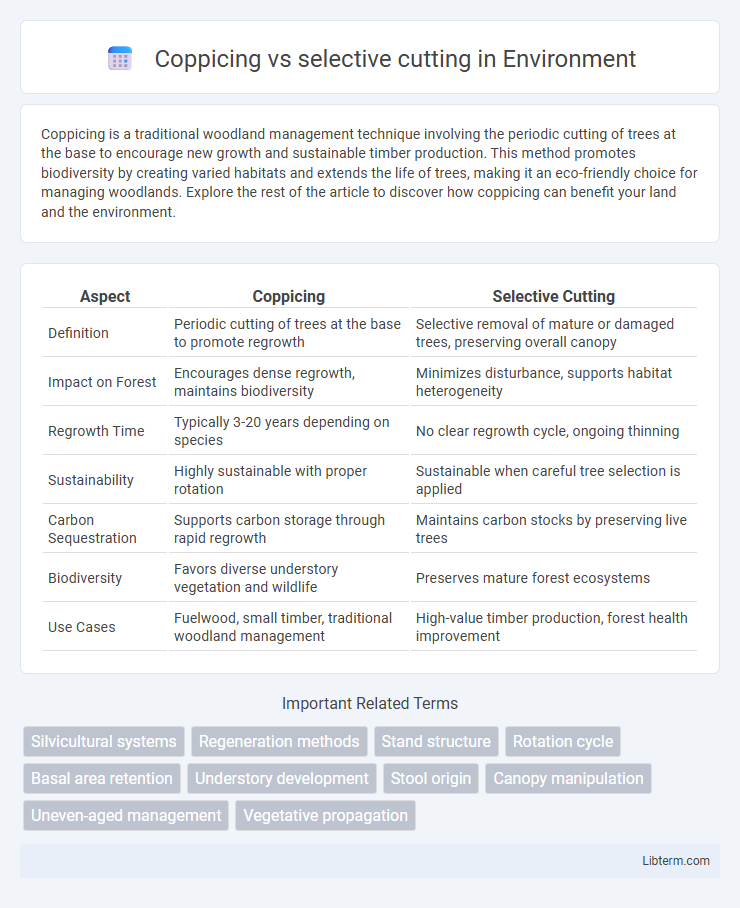Coppicing is a traditional woodland management technique involving the periodic cutting of trees at the base to encourage new growth and sustainable timber production. This method promotes biodiversity by creating varied habitats and extends the life of trees, making it an eco-friendly choice for managing woodlands. Explore the rest of the article to discover how coppicing can benefit your land and the environment.
Table of Comparison
| Aspect | Coppicing | Selective Cutting |
|---|---|---|
| Definition | Periodic cutting of trees at the base to promote regrowth | Selective removal of mature or damaged trees, preserving overall canopy |
| Impact on Forest | Encourages dense regrowth, maintains biodiversity | Minimizes disturbance, supports habitat heterogeneity |
| Regrowth Time | Typically 3-20 years depending on species | No clear regrowth cycle, ongoing thinning |
| Sustainability | Highly sustainable with proper rotation | Sustainable when careful tree selection is applied |
| Carbon Sequestration | Supports carbon storage through rapid regrowth | Maintains carbon stocks by preserving live trees |
| Biodiversity | Favors diverse understory vegetation and wildlife | Preserves mature forest ecosystems |
| Use Cases | Fuelwood, small timber, traditional woodland management | High-value timber production, forest health improvement |
Introduction to Coppicing and Selective Cutting
Coppicing is a traditional forest management technique where trees are periodically cut at the base to promote vigorous regrowth and sustainable timber harvest. Selective cutting involves carefully choosing and removing specific trees based on species, size, or health to maintain overall forest structure and biodiversity. Both methods support forest regeneration but differ in their approach to tree removal and ecosystem impact.
Definitions and Key Concepts
Coppicing is a traditional forest management technique involving the periodic cutting of trees near ground level to promote new shoot growth from the stump, allowing sustainable wood production. Selective cutting refers to the targeted removal of specific trees based on criteria such as size, species, or health, minimizing ecological disruption and maintaining forest structure. Both methods aim to balance resource extraction with ecosystem preservation but differ in approach and impact on forest dynamics.
Historical Background and Origins
Coppicing, an ancient forestry method dating back to Neolithic times, involves cutting trees at the base to promote regrowth and was widely used in medieval Europe for sustainable wood production. Selective cutting emerged more recently during the 19th and 20th centuries as a forestry practice aimed at harvesting mature trees individually while maintaining overall forest structure. Both techniques reflect evolving human forest management approaches shaped by cultural needs and ecological understanding over centuries.
Techniques of Coppicing
Coppicing is a traditional silvicultural technique involving the repeated cutting of tree stems at their base to promote new shoot growth, making it highly sustainable for hardwood production. This method encourages vigorous regrowth from stool stumps, which can be harvested on rotational cycles typically ranging from 7 to 20 years depending on species like hazel, willow, or oak. Selective cutting, in contrast, removes specific mature trees while preserving overall forest structure but does not stimulate the continuous regeneration characteristic of coppicing systems.
Methods of Selective Cutting
Selective cutting involves carefully choosing and harvesting specific trees based on criteria such as size, species, health, and commercial value to maintain forest structure and biodiversity. Methods include single-tree selection, where individual mature trees are removed, and group selection, which harvests small groups of trees to create openings for regeneration. This approach helps promote continuous forest cover, minimizes soil disturbance, and supports diverse wildlife habitats compared to the uniform regrowth seen in coppicing.
Ecological Impacts Compared
Coppicing promotes biodiversity by encouraging multiple regrowth cycles, which create varied habitats and enhance soil health through continuous organic matter input. Selective cutting minimizes canopy disturbance, preserving mature tree structures and promoting stable habitats for wildlife, but may result in reduced understory vegetation diversity compared to coppicing. Both methods influence nutrient cycling and carbon sequestration differently, with coppicing often leading to faster carbon turnover and selective cutting maintaining longer-term carbon storage.
Timber Yield and Regrowth Rates
Coppicing promotes rapid regrowth by cutting trees close to the base, allowing multiple shoots to sprout, which results in higher timber yield over shorter cycles compared to selective cutting. Selective cutting targets mature trees, preserving forest structure but leading to slower regrowth and less immediate timber output. Coppicing cycles range from 7 to 20 years, optimizing fast biomass production, whereas selective cutting intervals often exceed 30 years to ensure sustainable yield and ecosystem stability.
Wildlife Habitat and Biodiversity Effects
Coppicing promotes diverse wildlife habitats by creating a mosaic of age-structured vegetation that supports various species, enhancing biodiversity through increased light penetration and undergrowth regeneration. Selective cutting preserves mature trees and canopy continuity, maintaining habitat stability for canopy-dependent fauna and promoting species that rely on older forest structures. Both methods impact biodiversity differently: coppicing encourages early successional species and ground-level biodiversity, while selective cutting sustains species adapted to mature forest ecosystems.
Practical Considerations and Suitability
Coppicing is highly suitable for species that readily sprout from stumps, making it practical for sustainable fuelwood and small timber production with minimal soil disturbance. Selective cutting targets specific mature trees, preserving overall forest structure and biodiversity, which is ideal for mixed-species forests requiring conservation and commercial timber balance. Practical considerations include coppicing's rapid regrowth cycles versus selective cutting's slower recovery, influencing long-term forest management goals and ecological impact.
Choosing the Right Method for Your Woodland
Selecting the appropriate woodland management technique depends on forest composition and desired ecological outcomes. Coppicing promotes rapid regrowth by cutting trees at the base, ideal for sustainable timber and biodiversity enhancement in deciduous woodlands. Selective cutting removes specific mature trees to maintain overall forest structure and health, benefiting mixed or coniferous forests by minimizing ecosystem disruption while supporting timber production.
Coppicing Infographic

 libterm.com
libterm.com